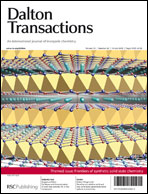A new monoclinic structure occurs for Er7Au2Te2 according to X-ray diffraction analysis of single crystals grown at 1200 °C: C2/m, Z = 4, a = 17.8310(9) Å, b = 3.9819(5) Å, c = 16.9089(9) Å, β = 104.361(4)°. The isostructural Lu7Au2Te2 also exists according to X-ray powder pattern means, a = 17.536(4) Å, b = 3.9719(4) Å, c = 16.695(2) Å, β = 104.33(1)°. The structure contains zigzag chains of condensed, Au-centered tricapped trigonal prisms (TCTP) of Er along c that also share basal faces along b to generate puckered sheets. Further bi-face-capping Er atoms between these generate the three dimensional network along a, with tellurium in cavities outlined by augmented trigonal prismatic Er polyhedra. Bonding analysis via LMTO-DFT methods reveal very significant Er–Au bonding interactions, as quantified by their energy-weighted Hamilton overlap populations (–ICOHP), ∼49% of the total for all interactions. These and similar Er–Te contributions sharply contrast with the small Er–Er population, only ∼14% of the total in spite of the high proportion of Er–Er contacts. The strong polar bonding of Er to the electronegative Au and Te leaves Er relatively oxidized, with many of its 5d states falling above the Fermi level and empty. The contradiction with customary representations of structures that highlight rare-earth metal clusters is manifest. The large Er–Au Hamilton overlap population is in accord with the strong bonding between early and late transition metals first noted by Brewer in 1973. The relationship of this structure to the more distorted orthorhombic (Imm2) structure type of neighboring Dy7Ir2Te2 is considered.

You have access to this article
 Please wait while we load your content...
Something went wrong. Try again?
Please wait while we load your content...
Something went wrong. Try again?


 Please wait while we load your content...
Please wait while we load your content...